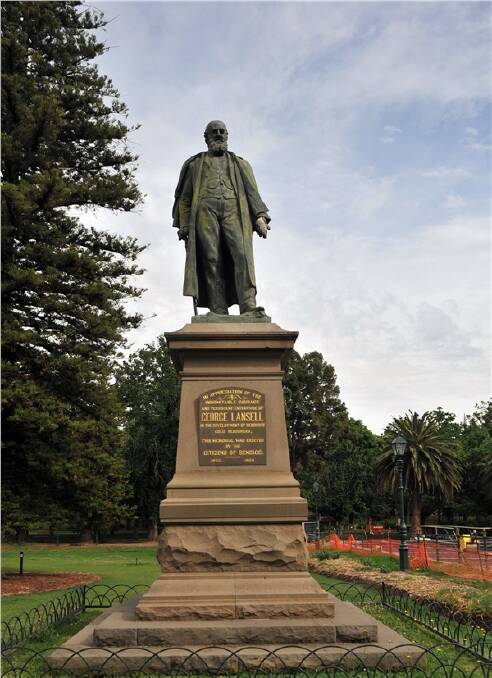
BENDIGO’S 'Quartz King', George Lansell, died at his home, Fortuna Villa, in March 1906.Shortly after Lansell’s death, the Bendigo and Eaglehawk Mine Managers’ Association held a meeting to discuss an appropriate memorial to the man who had played such a prominent part in the development of Bendigo’s gold resources. The president, Mr John Veale, reminded those present of George Lansell’s unique contribution to Bendigo. Unlike many who had obtained their wealth on the Bendigo goldfields and invested it elsewhere, said Mr Veale, “Mr Lansell put his money in land, bricks and mortar, lived here and died here, and his mines work on, giving employment’’.All 22 members present voted in favour of a motion requesting the Mayor to convene a public meeting of citizens “to consider the expediency of perpetuating the memory of the late Mr Lansell by erection of a statue or other means’’.A public meeting was duly convened by the Mayor, Cr L. Murphy.Mr Veale addressed the gathering, expressing the same sentiments as he had at the mine managers’ meeting. Mr Veale’s motion - that Bendigo erect a suitable memorial - was seconded by Mr Jacob Cohn, who had known George Lansell since the latter’s arrival in Sandhurst in 1853. The project received the immediate support of local business and civic leaders, including Mr J.H. McColl, MP; town clerk Mr W.D.C. Denovan; and Mr G.H. Crawford, president of the Mine Owners’ Association.A general committee was formed, whose members included the mayors of Melbourne, Castlemaine, Chewton, and Maldon. The executive committee comprised Cr Murphy as chairman, Mr N. Howell, treasurer, and Messrs Honeybone and Wilson as secretaries. Also on the local committee were Messrs J. Veale; W.D.C. Denovan; J.H. McColl; W. Beebe; J. Cohn; G. Mackay; J. Langdon; J. Hedley; A. Hicks MLC; H. Kirkwood MLA; R.H.S. Abbott; Eaglehawk Mayor Cr J. Trevean; G.H. Crawford; W. Broadbridge; T. Grose; and Dr Green.Funds for the construction of a memorial statue were raised by subscription. Within weeks, more than 200 pounds had been committed. The Bendigo Stock Exchange donated 50 pounds. In 1906 James White, sculptor of the Queen Victoria statue in Rosalind Park, overlooking Pall Mall, was chosen by the committee to execute the commission.Born in Liverpool, England, in 1861, James White was the son of a shipwright.Apprenticed to a plasterer, he studied modelling in London, and made anatomical models for London hospitals. While as assistant to the Scottish sculptor John Rhind, White executed a bas-relief of surgeon John Hunter, for the University of Edinburgh.From this point, White saw himself as an artist and sculptor, rather than as a technician.James White arrived in Sydney in about 1884. He worked for sculptor Achille Simonetti in the late 1880s on Governor Phillip’s monument in Sydney’s Botanic Gardens. He began exhibiting with the Art Society of NSW in 1891. By 1897 he had established a small foundry at Petersham, and advertised his willingness to supply works cast in plaster or bronze, or carved in marble. White campaigned vigorously for commissions for public statuary to be given to Australian sculptors.In the early 1900s, James White was the busiest sculptor in Australia. In 1902, he was the first sculptor to win the Wynne prize. His numerous commissions included a marble statue of John McDouall Stuart for Adelaide; a bronze statue of Sir John Robertson in the Botanic Gardens in Sydney; South African war memorials in Perth and Ballarat; and the statue of Queen Victoria in Rosalind Park, Bendigo, which was unveiled in 1903.Despite not having known him in life, James White achieved a good likeness of George Lansell.He used photographs of his subject, including a portrait by Bendigo photographers Bartlett Bros - the last studio portrait taken of George Lansell. White’s figure of the 'Quartz King' is 3.1 metres high.Lansell is depicted in his characteristic attire of breeches, buttoned waistcoat, and overcoat. In his left hand he holds a lump of quartz. The statue is mounted on a sandstone pedestal, 3.3 metres in height. Two bluestone steps form a plinth beneath the pedestal, and the whole edifice stands on a grass-covered mound. Three of the four sides of the pedestal depict, in bas-relief, scenes from the early days of gold-mining in Bendigo.The front panel of the pedestal bears the inscription: “In appreciation of the indomitable courage and persistent enterprise of George Lansell in the development of Bendigo’s gold resources, this memorial was erected by the citizens of Bendigo. 1823-1906’’.The George Lansell memorial, in the corner of the gardens adjoining Williamson St and Pall Mall, was unveiled on December 9 1908, by the Governor of Victoria, Sir Thomas Gibson Carmichael, before a crowd of approximately 2000 people.Bendigo Mayor, Cr Abraham Harkness, accepted the statue on behalf of the citizens.Among the guests of honour present for the occasion were George Lansell’s widow, Mrs Edith Lansell, and her mother, Mrs Sarah Bassford. Beverley Carter is a retired secondary school teacher, and a part-time journalist, reviewer, and editor. A member of Bendigo’s Lansell family, she is currently writing a comprehensive history of her family, from their European and English origins, to their contribution to the development of Bendigo.Her Fortuna Glimpses series focuses on the life of mining magnate George Lansell, and his home, Fortuna Villa.
Subscribe now for unlimited access.
$0/
(min cost $0)
or signup to continue reading

